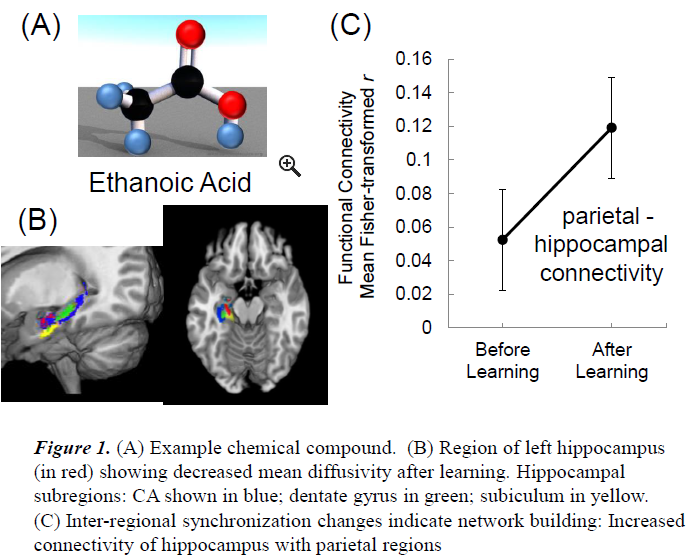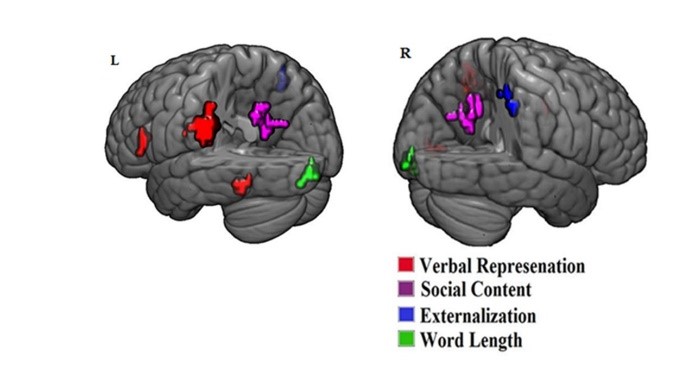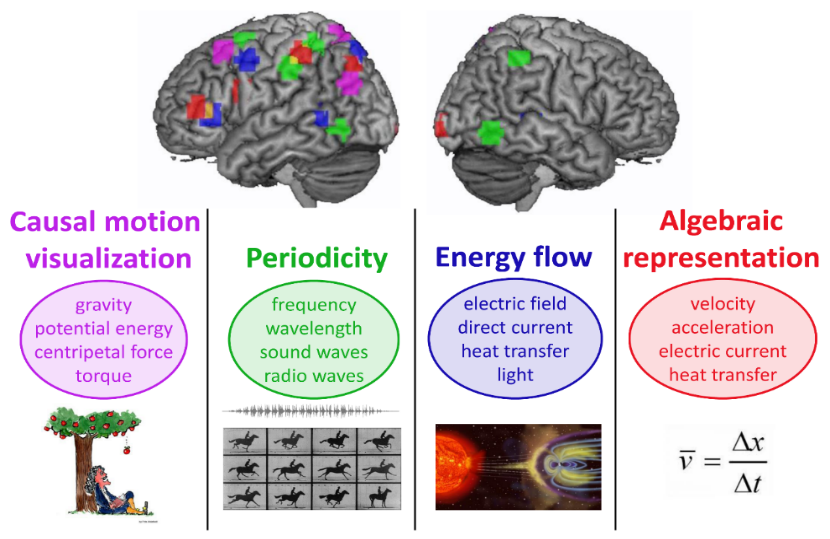Projects
The Neurocognitive Basis of Knowledge Acquisition: Building Better Brains
This ONR-funded project investigates the cognitive and neural mechanisms through which new concepts and new knowledge are learned, maintained, and remediated with instructional interventions. The goal is to use neural data to develop novel approaches to (1) instruction in the learning of new concepts in ways that take the neural representation into account; (2) the neural assessment and remediation of poorly learned or forgotten concepts; (3) the assessment of tissue changes and functional connectivity changes in various spatial learning environments. The concepts and systems to be learned come from technical domains (e.g., mechanics, physics, electronics, chemistry, etc.).
Several converging measures of neural change are acquired, such as white matter changes, gray matter changes, activation changes in a set of gray matter areas, and changes in synchronization (functional connectivity) among the activated areas. The goal of the research is to enable assessment of both technical/science learning ability as well as successful vs insufficient learning, with the intent to develop design principles for instructional materials that will accelerate learning and characterize individual differences in learning.
The goal of these studies is to transition from determining how new concepts are formed in the brain to developing methods for optimizing learning and maintaining of concepts, while at the same time advancing our understanding of how the brain represents technical and science-related concepts.
A central forthcoming focus is on individual differences among people in their neural learning characteristics. We know that some people learn better or faster than others. The project will aim to discover the neural basis of such individual difference. The main approach will be to acquire the neural representations of newly-learned concepts and knowledge domains, and determine which neural characteristics predict behavioral performance. The neural assessment of learning could result in enhanced instructional methods and in improved personnel selection techniques.
Brain changes during the learning of organic chemistry compounds
Learning organic chemistry compounds brings about neural changes at gray matter microstructure level, informational level, and cortical network level, all occurring in the same location of the hippocampus. This project has added a new dimension to our understanding of the role of the hippocampus in human learning. The main goal was to provide a single investigation of the neural changes that occur during learning using different types of imaging technologies that are seldom integrated. Here we show that a small hippocampal region (dentate gyrus and CA3) changes as the structures and names of a set of organic compounds are being learned, reflecting changes at the microstructural, informational, and cortical network levels. The co-location of these hippocampal changes reflects that structure’s involvement in learning at all three levels of explanation, consistent with the multiple ways in which learning brings about neural change.
The study collected the three types of data to examine each of these neuroimaging metrics of learning in a one-hour MRI scan. The items were selected to have ecological validity for typical introductory organic chemistry courses taught in high-school and college settings. The stimuli were 2D depictions of 3D visuospatial representations (colored sphere-and-rod models) of compounds studied in such settings (Figure 1A). The learning involved the acquisition of the relationship between the visuospatial representations of molecules and their verbal labels used in standard chemistry nomenclature, such that given the label, the student could generate the structure. In the extraordinary measure of learning in the current study, the participants are prompted with the verbal label, and mentally generate the corresponding structure, and that mental structure is assessed for accuracy using the new “brain-reading” methods that our laboratory has developed. Learning is also assessed using a conventional behavioral measure.

The study found three types of neural changes in the same parcel of brain tissues (~1.3 cm3) in the left hippocampus while participants reliably learned the spatial configuration of a set of organic compounds.
- The informational change concerning the structure of individual compounds occurred as the structure gradually came to be present in this hippocampal location, indicated by the classifier’s ability to reliably identify the organic molecule on the basis of its retrieved spatial configuration (when participants were prompted by only the compound’s name).
- The mean diffusivity within this same gray matter volume reliably decreased, suggesting that microstructural neuroplastic changes in the dentate gyrus and CA play a role in consolidating the concept. Animal models have shown that such decreases in water molecule diffusivity are associated with synaptic and glial change.
- Functional connections to cortical regions that process spatial information were being established, as indicated by increased synchronization with those regions (Figures 1B & 1C).
The co-location of these three types of neural changes during concept learning indicates the centrality of this hippocampal parcel in the neural establishing of usable new knowledge of the spatial properties of a concept, and illustrates some of the learning mechanisms that are involved.
This study by Just and Keller was published in Brain Structure and Function
The brain’s processing of “ethics” and other abstract ideas you can’t see
CCBI researchers at Carnegie Mellon have leveraged machine learning to interpret human brain scans, revealing how regions of the brain assemble the thought of abstract concepts, like justice, ethics and consciousness. The account was confirmed by correctly predicting the activation patterns corresponding to held-out abstract concepts.
“Humans have the unique ability to construct abstract concepts, like consciousness that have no anchor in the physical world, but we often take this ability for granted,” said Marcel Just, the D.O. Hebb University Professor of Psychology at CMU’s Dietrich College of Humanities and Social Sciences and senior author on the paper. “In this study, we have shown that newly-identified meaning components used by the human brain act like an indexing system, similar to a library’s card catalog, to compose the meaning of abstract concepts.”
The ability of humans to think abstractly plays a central role in scientific and intellectual progress. Unlike a concrete concept, like hammer, which is processed by brain regions involved in holding, seeing, and wielding a hammer, abstract concepts like ethics have no obvious home in the brain’s perceptual or motor systems.
“By definition, you can’t form a mental image of an abstract thought,” said Robert Vargas, a CMU graduate student at the CCBI and first author on the paper. “Most of our understanding of how the brain processes objects and concepts is based on how our five senses take in information, but it becomes difficult to describe the neural environment of abstract thoughts because many of the brain’s mental tools to process them are themselves abstract.”
The fMRI brain activation data was analyzed using machine learning tools to find the activation patterns that corresponded to each of the 28 abstract concepts. Once the machine learning algorithm learned the patterns in one subset of the data, it was able to successfully identify each concept in an independent subset of the data.
These abstract concepts are neurally underpinned by three dimensions of meaning in the brain. The first dimension corresponds to activation in a language-related region, and represents the abstract word-concept in terms of other concepts. For example, the concept of ethics might be linked to other words like rules and morals, rather than being linked to anything in the outside world.
The second dimension defines abstract concepts in terms of reference to oneself versus to an external frame of reference. For example, spirituality refers to self, while causality is external to the self. The self–related concepts evoked activation in brain regions involved in self-reflection. The final dimension is rooted in social constructs. Concepts such as pride and gossip were strongly associated with this dimension.

One of the most surprising outcomes was the commonality of the concept representations across participants. “For me, the most exciting result of this study was that we were able to predict the neural activation patterns for individual abstract concepts across people,” Vargas said. “It is wild to think that my concept of probability and spirituality is neurally similar to the next person’s, even if their experience of spirituality is different.”
The 28 concepts covered in the study span seven categories: mathematics (subtraction, equality, probability and multiplication); scientific (gravity, force, heat and acceleration); social (gossip, intimidation, forgiveness and compliment); emotion (happiness, sadness anger and pride); law (contract, ethics, crime and exoneration); metaphysical (causality, consciousness, truth and necessity); and religiosity (deity, spirituality, sacrilege and faith).
These findings indicate that the neural organization of abstract concepts relies on systems associated with higher-order cognitive processing rather than lower-order perceptual processing. That is, abstract concepts rely on systems involved with language processing (LIFG, left inferior frontal gyrus), third-person perspective taking (RSMG, right superior middle gyrus), and the processing of episodic memories related to social content (PCC, posterior cingulate).
“It’s flashy to call this work mind reading,” Just said. “For me, it is proof that we have identified some of the elements of the brain’s indexing system — verbal representation, externality/internality and the social dimension — that our brains use to code concepts that have no physical manifestation in the world.”
The article, titled “Neural representations of Abstract Concepts: Identifying Underlying Neurosemantic Dimensions” appears in Cerebral Cortex. This research received funding from the Office of Naval Research.
A brain-based account of “basic-level” concepts.
Basic level concepts (e.g., bird), in contrast to robin (subordinate) or animal (superordinate) reside in a privileged position in the knowledge hierarchy in semantic cognition. Basic-level terms are generated faster than terms at other levels, and are used earlier by children. Furthermore, basic-level terms are the nouns most frequently used in text. This level is particularly relevant for the learning of concepts and the development of depth of knowledge in a domain. The basic-level advantage of semantic content helps to characterize concepts at each level of abstraction, as opposed to structural properties of the levels such as distinctiveness. This study provides a brain-based account of how object concepts at an intermediate (basic) level of specificity are represented, offering an enriched view of what it means for a concept to be a basic-level concept, a research topic pioneered by Rosch and others.
The neural representation of basic-level concepts is spatially broad, encompassing sensorimotor brain areas that encode concrete object properties, but also language and heteromodal integrative areas that encode abstract semantic content. The representation of subordinate-level concepts (robin) was less widely distributed in several perceptual areas that underlie concrete content. Furthermore, basic-level concepts were representative of their subordinates in that they were neurally similar to their typical but not atypical subordinates (bird was neurally similar to robin but not woodpecker). The findings provide a brain-based account of the advantages that basic-level concepts enjoy in everyday life over subordinate-level concepts. The basic level is neurally represented as a broad topographical representation that encompasses both concrete and abstract semantic content, reflecting the multifaceted yet intuitive meaning of basic-level concepts. The representation of the basic level is a balanced activation of sensorimotor, verbal, and heteromodal integrative centers of the semantic system, perhaps revealing an optimal neural configuration for the processing or use of such concepts. This study by Bauer and Just was published in NeuroImage.
How Scientific Concepts Are Represented in the Brain
Building on groundbreaking research that identified the brain representations of elementary physics concepts, Carnegie Mellon University’s Robert Mason and Marcel Just have received a grant from the National Science Foundation (NSF) to investigate the brain representations of physics concepts in college students and determine their relation to the students’ academic performance. Although the implicit goal of most educational practices is to change students’ brains, advancing what the students know, this new project will assess how the neural growth of the new knowledge is related to performance in course exams.
“This project is based on two key capabilities that we demonstrated in earlier work,” said Mason, a senior research associate in Dietrich College of Humanities and Social Sciences’ Department of Psychology. “First is our ability to identify what physics concept a student is thinking about from its brain activation pattern, that is, to find the concept’s brain signature. Second, we can trace the progress of an individual student’s concept representations over a semester, looking for neural biomarkers of successful learning in a complex STEM domain. We can then assess the quality of the resulting neural representations by comparing them to the neural representations of previously successful students and to the representations of the instructors.”
 The four underlying dimensions of representation of 30 physics concepts
The four underlying dimensions of representation of 30 physics concepts The research applies machine learning techniques to fMRI brain activation patterns that correspond to specific concepts. The researchers discovered that unique brain representations of concepts like velocity or mass can be measured and individually distinguished. They also found that the neural representations of relatively new science concepts, only a few hundred years old, are rooted in ancient brain systems. For example, the neural representation of frequency uses some of the same brain systems as the processing of the waxing and waning of a sound.
“It is now possible to watch a concept ‘grow’ in the brain as its properties are being learned,” said Just, the D. O Hebb University Professor of Psychology. “Furthermore, everyone’s brain organizes the concept knowledge similarly, making it possible to meaningfully compare the representations of different students. Do some students end up with better or more robust representations of physics concepts than others? Should the tuition that a student is charged be proportional to the amount of their brain learning?”
The new grant will allow Mason and Just to examine the brain representations of concepts in students enrolled in an introductory physics class at the beginning and end of the course. They will assess how the neural representations changed over the semester and how the neural changes are related to grades on course exams. They will also examine how the quality of the neural representations is related to various measures of cognitive abilities, such as spatial ability or fluid intelligence.
The main outcome of this project will be a neurally-informed understanding of how individual scientific concepts are learned and how this learning can be enhanced. The research will reveal which brain systems are used to represent physics concepts, how neural representations of physics concepts change with learning (in terms of their organization and increasing similarity to instructors’ representations), how well the neural measures predict behavioral test measures and, perhaps most impactfully, how physics instruction and testing might be modified to enhance learning.
“Our brains that were designed tens of thousands of years ago can now learn new physics concepts by ‘repurposing’ brain systems that were originally evolved for processing information about our environment,” said Just. “The main underlying dimensions of representation, such as frequency and energy flow, represent information that mankind has been processing for millennia. This new grant will determine if we can leverage the cognitive neuroscience insights to improve science education.”
